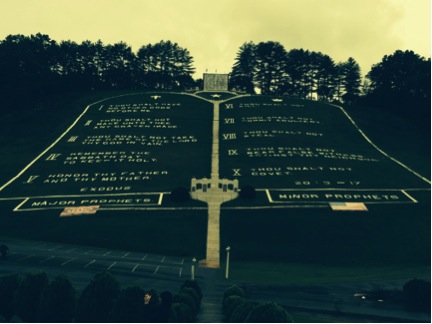By Katherine Makepeace – 2014

“And all things whatsoever ye shall ask in prayer, believing ye shall receive,” [Matt. 21:22]. This was just one of the many biblical quotes embedded in the infrastructure of the Fields of the Wood Bible Park, home of the world’s largest Ten Commandments. This quote and the others like it set the tone for a day of self-reflection. Gentle, early morning rains kissed the open grounds of the park, including the giant Ten Commandments that sprawled across a tall hill and displayed itself open-faced toward the sky. There were no other visitors on this weekday morning. I was tired from the 6-hour drive the previous night, but my spirits were still high.
I am not a religious person by any means, but I am spiritual. I believe that all religions have different ways of representing fundamental truths about the universe and the meaning of our existence. Still, I was unsure of what this place would hold for me as a non-Christian visitor. I wondered if I would appear noticeably out of place or unknowledgeable about the contents of the park. What I found was an ideal space for personal reflection, set amidst a field enclosed by a gorgeous wood, a warm and welcoming staff, and a perfect start to my morning.
What surprised me about the park were its many multi-purpose buildings and features. The property’s highlight is, of course, the world’s largest Ten Commandments. The park also has a baptismal pool, outdoor and indoor chapels, a picturesque duck pond, replicas of Jesus’ tomb and Golgotha, picnic areas, nature trails, a gift shop and café, as well as my personal favorite – Prayer Mountain.
The Ten Commandments can be viewed best from a hill opposite, from some steps at the bottom of Prayer Mountain. The archway that marks the beginning of this path features quotes from the Bible, such as the one mentioned at the start of this article. Beyond the archway is a long path of steps that leads to a concrete courtyard. The path is lined with signs, sponsored by Churches of Christ from all 50 states, that address popular religious topics like the seven deadly sins, the importance of observing the Sabbath, or the dangers of drug abuse. These signs refer specifically to morphine and opium, and the significance that temperance held in the early-to-mid 20th century. The dated references were not unwelcome to me, as they reflect the fascinating historical significance of this park, and reveal it as a snapshot of American Christian values over time. The path also features a burnt tree that was struck by lightning, which many understand to be a message from God. At the summit, the Lord’s Prayer is displayed on a plaque. There is also an altar for prayer, where hundreds of visitors have left a myriad of notes in different colors, outlining their hopes and dreams, which they hope “shall be received.” As I peered down at this soggy rainbow pile of people’s deepest worries and desires, I somehow felt closer to humanity.
